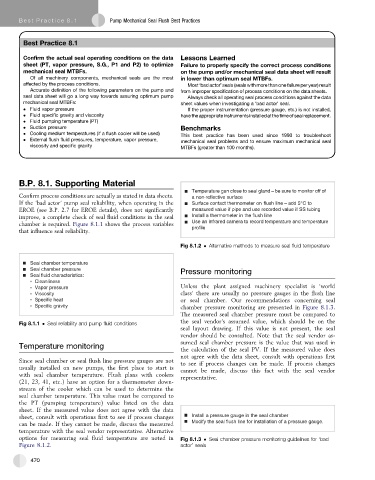Page 499 - Subyek Teknik Mesin - Forsthoffers Best Practice Handbook for Rotating Machinery by William E Forsthoffer
P. 499
Be st Practice 8 .1 Pump Mechanical Seal Flush Best Practices
Best
Best Practice 8.1Practice 8.1
Confirm the actual seal operating conditions on the data Lessons Learned
sheet (PT, vapor pressure, S.G., P1 and P2) to optimize Failure to properly specify the correct process conditions
mechanical seal MTBFs. on the pump and/or mechanical seal data sheet will result
Of all machinery components, mechanical seals are the most in lower than optimum seal MTBFs.
affected by the process conditions. Most ‘bad actor’ seals (seals with more thanone failure per year) result
Accurate definition of the following parameters on the pump and from improper specification of process conditions on the data sheets.
seal data sheet will go a long way towards assuring optimum pump Always check all operating seal process conditions against the data
mechanical seal MTBFs: sheet values when investigating a ‘bad actor’ seal.
Fluid vapor pressure If the proper instrumentation (pressure gauge, etc.) is not installed,
Fluid specific gravity and viscosity havetheappropriateinstrumentsinstalledatthetimeofsealreplacement.
Fluid pumping temperature (PT)
Suction pressure Benchmarks
Cooling medium temperatures (if a flush cooler will be used)
This best practice has been used since 1990 to troubleshoot
External flush fluid pressures, temperature, vapor pressure, mechanical seal problems and to ensure maximum mechanical seal
viscosity and specific gravity MTBFs (greater than 100 months).
B.P. 8.1. Supporting Material
Temperature gun close to seal gland – be sure to monitor off of
Confirm process conditions are actually as stated in data sheets. a non-reflective surface
If the ‘bad actor’ pump seal reliability, when operating in the Surface contact thermometer on flush line – add 5°C to
EROE (see B.P. 2.7 for EROE details), does not significantly measured value if pipe and use recorded value if SS tubing
improve, a complete check of seal fluid conditions in the seal Install a thermometer in the flush line
chamber is required. Figure 8.1.1 shows the process variables Use an infrared camera to record temperature and temperature
that influence seal reliability. profile
Fig 8.1.2 Alternative methods to measure seal fluid temperature
Seal chamber temperature
Seal chamber pressure Pressure monitoring
Seal fluid characteristics:
• Cleanliness
• Vapor pressure Unless the plant assigned machinery specialist is ‘world
• Viscosity class’ there are usually no pressure gauges in the flush line
• Specific heat or seal chamber. Our recommendations concerning seal
• Specific gravity chamber pressure monitoring are presented in Figure 8.1.3.
The measured seal chamber pressure must be compared to
the seal vendor’s assumed value, which should be on the
Fig 8.1.1 Seal reliability and pump fluid conditions
seal layout drawing. If this value is not present, the seal
vendor should be consulted. Note that the seal vendor as-
sumed seal chamber pressure is the value that was used in
Temperature monitoring
the calculation of the seal PV. If the measured value does
not agree with the data sheet, consult with operations first
Since seal chamber or seal flush line pressure gauges are not to see if process changes can be made. If process changes
usually installed on new pumps, the firstplace tostartis
cannot be made, discuss this fact with the seal vendor
with seal chamber temperature. Flush plans with coolers representative.
(21, 23, 41, etc.) have an option for a thermometer down-
stream of the cooler which can be used to determine the
seal chamber temperature. This value must be compared to
the PT (pumping temperature) value listed on the data
sheet. If the measured value does not agree with the data
sheet, consult with operations first to see if process changes Install a pressure gauge in the seal chamber
can be made. If they cannot be made, discuss the measured Modify the seal flush line for installation of a pressure gauge.
temperature with the seal vendor representative. Alternative
options for measuring seal fluid temperature are noted in Fig 8.1.3 Seal chamber pressure monitoring guidelines for ‘bad
Figure 8.1.2. actor’ seals
470

